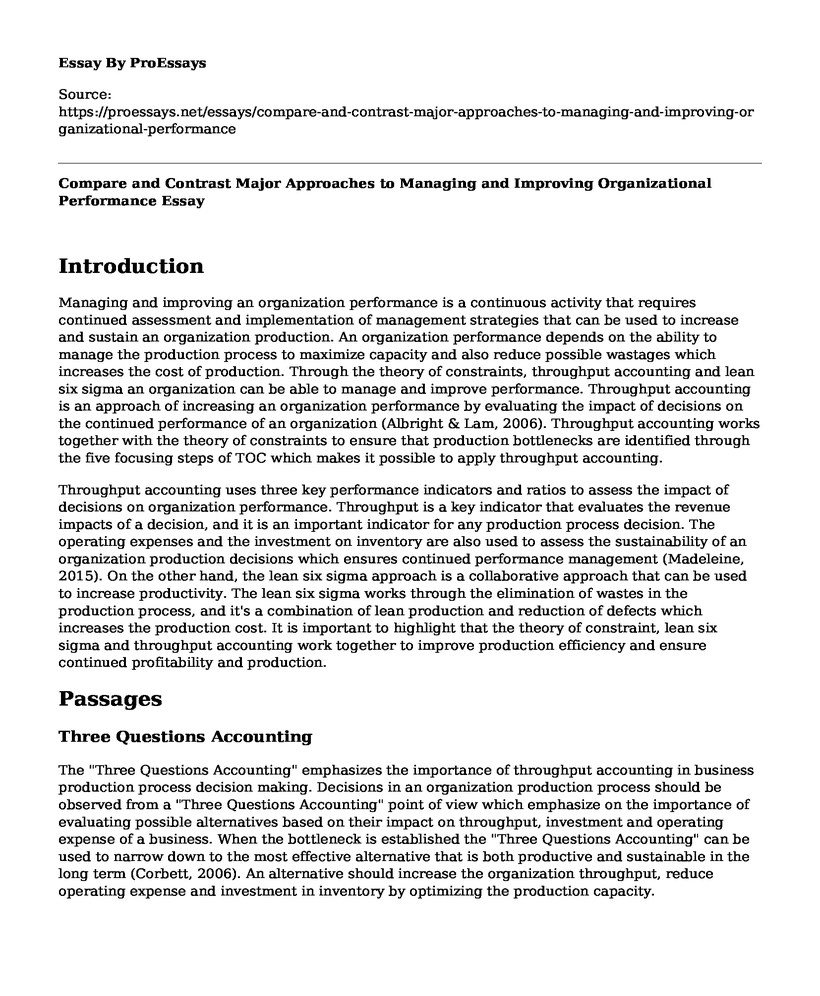Introduction
Managing and improving an organization performance is a continuous activity that requires continued assessment and implementation of management strategies that can be used to increase and sustain an organization production. An organization performance depends on the ability to manage the production process to maximize capacity and also reduce possible wastages which increases the cost of production. Through the theory of constraints, throughput accounting and lean six sigma an organization can be able to manage and improve performance. Throughput accounting is an approach of increasing an organization performance by evaluating the impact of decisions on the continued performance of an organization (Albright & Lam, 2006). Throughput accounting works together with the theory of constraints to ensure that production bottlenecks are identified through the five focusing steps of TOC which makes it possible to apply throughput accounting.
Throughput accounting uses three key performance indicators and ratios to assess the impact of decisions on organization performance. Throughput is a key indicator that evaluates the revenue impacts of a decision, and it is an important indicator for any production process decision. The operating expenses and the investment on inventory are also used to assess the sustainability of an organization production decisions which ensures continued performance management (Madeleine, 2015). On the other hand, the lean six sigma approach is a collaborative approach that can be used to increase productivity. The lean six sigma works through the elimination of wastes in the production process, and it's a combination of lean production and reduction of defects which increases the production cost. It is important to highlight that the theory of constraint, lean six sigma and throughput accounting work together to improve production efficiency and ensure continued profitability and production.
Passages
Three Questions Accounting
The "Three Questions Accounting" emphasizes the importance of throughput accounting in business production process decision making. Decisions in an organization production process should be observed from a "Three Questions Accounting" point of view which emphasize on the importance of evaluating possible alternatives based on their impact on throughput, investment and operating expense of a business. When the bottleneck is established the "Three Questions Accounting" can be used to narrow down to the most effective alternative that is both productive and sustainable in the long term (Corbett, 2006). An alternative should increase the organization throughput, reduce operating expense and investment in inventory by optimizing the production capacity.
Throughput Metrics Meet Six Sigma
The passage on "Throughput Metrics Meet Six Sigma" is used to emphasize the need to combine throughput accounting and six sigma to increase production of an organization. An organization performance requires sustainability through improved capacity and reduced cost of production which occurs most of the times due to defects in the final products. Whereas the throughput metrics emphasize assessing the impacts of a decision on the revenue of an organization reducing defects by improving quality can be used to promote an organization performance (Aghili, 2011). Throughput metrics ensures that an organization production process is within the recommended throughput, costs and inventory while the six sigma ensures that an organization eliminates all the defects which streamline the production process.
The Synergy of Continuous Process Improvement
The "The Synergy of Continuous Process Improvement" seeks to expound on the importance of integrating the lean, six sigma and the theory of constraints to ensure continuous improvement in an organization. Apart from eliminating bottlenecks in an organization production process integrating the lean and six sigma leads to continuous improvement in organization products. After identification of the bottleneck which is mostly in the production capacity, the lean six sigma can be used to eliminate wastes and defects (Pirasteh & Kannappan, 2013). The wastes are in the form of time, resources, effort and talent which improves production efficiency and reduces costs.
References
Aghili, S. (2011). Throughput metrics meet six sigma. Management Accounting Quarterly, 12(3), 12.
Albright, T., & Lam, M. (2006). Managerial accounting and continuous improvement initiatives: A retrospective and framework. Journal of Managerial Issues, 157-174.
Corbett, T. (2006). Three-questions accounting. Strategic Finance, 87(10), 48.
Jones, C. S., & Tuzel, S. (2013). Inventory investment and the cost of capital. Journal of Financial Economics, 107(3), 557-579.
Madeleine, T. (2015). Bottleneck Analysis and Throughput Improvement through Simulation-Based Multi-Objective Optimization.
Pirasteh, R. M., & Kannappan, S. (2013). The synergy of continuous process improvement. Industrial Engineer, 45(6), 41-45.
Cite this page
Compare and Contrast Major Approaches to Managing and Improving Organizational Performance. (2022, Jul 26). Retrieved from https://proessays.net/essays/compare-and-contrast-major-approaches-to-managing-and-improving-organizational-performance
If you are the original author of this essay and no longer wish to have it published on the ProEssays website, please click below to request its removal:
- Inventory Management in Wheeled Coach. Case Study Example.
- Paper Example on Mergers and Acquisitions
- Describe a Compensation Strategy for an Organization Paper Example
- Essay Example on Eleanor Roosevelt: Defining Leadership & Putting It Into Practice
- Essay Example on DuPont Model: Essential Financial Analysis Framework
- Paper Sample on Benchmarking: Management Process for Continuous Improvement
- Essay on Good Leadership: Essential for Company's Success







